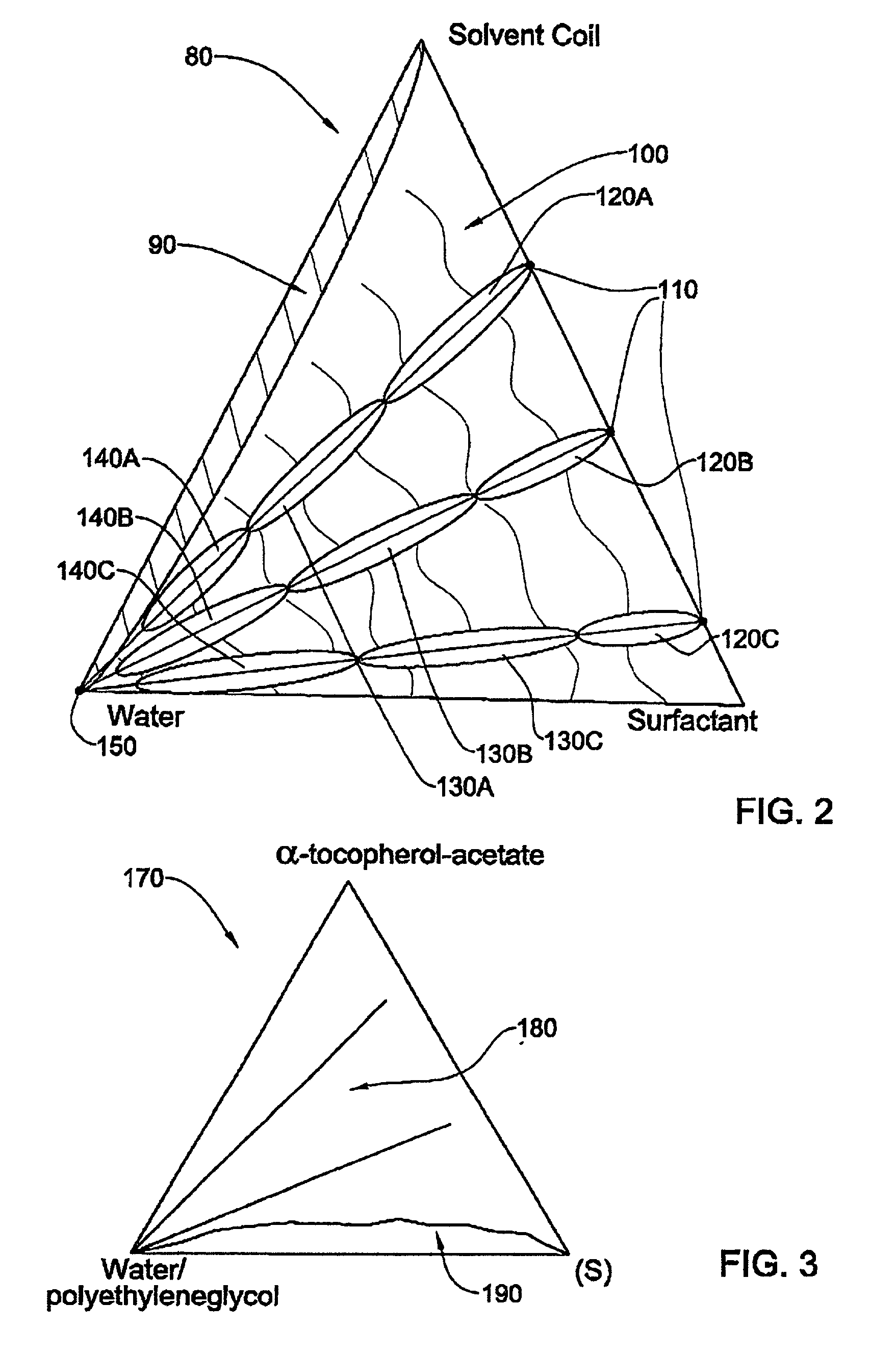0028] FIG. 5A shows a phase diagram of a system for solubilizing phytosterol. The system is comprised of an aqueous phase comprising water/propylene glycol in a 1:1 ratio, an oil phase comprising of limonene/ethanol in a 1: 1 ratio, and Tween 60 as the surfactant, where the ratio of the surfactant to the oil phase is 3:2 (indicated as the 64 line). It should be noted that the ratio between each of the components of the oil phase to the surface is 1:3. The solubility capacity of such a system is given in FIG. 5B for a system comprising 1 Kg of nano-sized self-assembled structured concentrate. As shown, the maximum solubilization is 165 mg, i.e. maximum solubilization is 1.65% (wt) reached at the point where the aqueous phase is 50%. Upon dilution, the solubilization drops as demonstrated by the dilution of the system from 50% water to 80% water. The factor for the dilution is 80/50=1.3, while, as can be seen from the figure, the solubilization decrease factor is 165 mg/45 mg=3.6 or 0.165/0.045=3.6, once again demonstrating that upon dilution, the solubilization factor drops over the dilution factor. Turing to FIG. 5C, the efficiency of the solubilization in the described system is represented (.alpha.). The efficiency factor, .alpha., is defined as phytosterol/oil(wt/wt)X 100. As shown the maximum solubilization on an oil base is 16.7 wt %. It should be noted that the solubilization decreases as the percentage of the aqueous phase increases. FIG. 5D illustrates the solubilization efficiency of phytosterol at different surfactant/oil ratio at two aqueous phase concentrations, 50% and 60%. The efficiency of solubilization of phytosteol increases for both aqueous concentrations as the ratio of the surfactant to oil increases. From FIGS. 5C and 5D it is apparent that the solubilization factors are 6, 7 for concentrate. Turning to FIG. 6A there is shown a phase diagram of a system for solubilizing lutein. The system is comprised of an aqueous phase comprising water/glycerol in a 3:1 ratio, an oil phase comprising of limonene/ethanol in a 1:2 ratio, and Tween 80 as the surfactant. The ratio of the surfactant to the oil phase may either be 1:1 or 3:2 (indicated as lines 5.5 or 6.4). It should be noted that such a system might display at different ratios of the components, a two-phase system (demonstrated by the shady area). FIG. 6B shows the maximum solubilization that can be achieved with increasing concentration of the aqueous phase in the two systems where the ratio of the oil phase to surfactant may be either 3:2 or 1:1. It is apparent from the findings that the maximum solubilization for the two systems occurs in the bi continuous region (ca. 40 to 60% aqueous solution). For both systems, in the region where oil in water system (O/W) prevails, i.e. where the concentration of the aqueous solution is over 50%, there is limited solubilization. FIGS. 6C and 6D show the solubilization efficiency of lutein normalized to the surfactant or oil concentration respectively, for both 5.5 and 6.4 systems. As shown, solubilization is enhanced as the concentration of the surfactant is increased. FIGS. 7A and 7B show a comparison of solubilization efficiency of lutein ester compared to that of free lutein normalized to the surfactant or oil concentration, respectively, for 6:4 system. Tie different solubilization profiles of the two compounds demonstrates that their solubilization should be done in different environments. While the free lutein should be solubilized in a water in oil environment, the ester should be solubilized in a oil in water environment. As demonstrated in FIG. 2 the nano-sized self-assembled concentrates of the present invention may either be an aqueous phase or an oil phase, thus these two compounds may be solubilized efficiently.
0029] The present invention provides novel nano-sized self-assembled structured concentrates formed by mixing of an oil phase, an aqueous phase and a surfactant. The ternary system forms nano-sized concentrates that are different than the classical microemulsion concentrate in their size and shape, being in the range of 1.5-80 nM which is 2-3 orders of magnitude lower than tat of classical emulsions, microemulsions or self-assembled structured concentrates. The nano-sized concentrates of the present invention enable in an efficient manner the solubilization, transport and dilution of oil-soluble, oil non-soluble or water-soluble nutraceuticals, food supplements, food additives, plant extracts, medicaments, peptides, proteins or carbohydrates. Thus they may be used as efficient vehicles for transport of active materials into the human body. The capability of these nano-sized self-assembled structured concentrates to solubilize the desired active component exceeds many-fold the solubility capacities of the aqueous or oil phase alone or of the aqueous or oil phase in the presence of an appropriate surfactant. As shown in FIGS. 4-6 for lycopene, phytoserol and lutein, respectively, the increase is in the range of 7-20 fold. Furthermore, the nano-sized self-assembled structured concentrates, once formed, may be diluted as desired in either oil or water while a single phase is maintained and the nano-sized structured concentrate is intact. The aqueous phase comprises of water, co-surfactants and a polyol co-solvent. The co-surfactant is selected from C.sub.2-16-alcohols, most preferred are ethanol, propanol, butanol or pentanol or their mixtures. Non-limiting examples of the polyol co-solvent are aldo- or keto- sugars, oligomeric carbohydrates such as glycerol, ethylene glycol, propylene glycol, sorbitol, xylitol, glucose, and fructose. The oil phase is comprised of a solvent and may ether comprise a co-solvent. The solvent is selected from the group consisting of C.sub.2-C.sub.6-alcohol, long chain fatty alcohols, C.sub.2-C.sub.6-ketone, C.sub.2-C.sub.6-aldehyde, +E,uns, C.sub.2-24-fatty acid or their esters, terpene, terpin, terpinene, limonene, penta- or -tetracyclic triterpenic alcohols, sterol, alkylsterol, essential oil, fat soluble lipidic vitamins, fennel oil, ginger oil, lavender oil, eucalyptus oil, anise oil, lemon oil, mandarin oil, peppermint oil, oregano oil, lime oil, tangerine oil, spearmint oil, triethyl citrate, ethyl oleate, ethyl caprylate, anisole, anisol alcohol, benzyl acetate, benz
 Login to View More
Login to View More 


